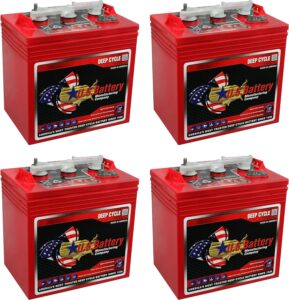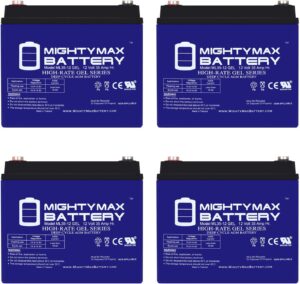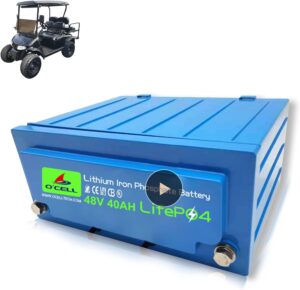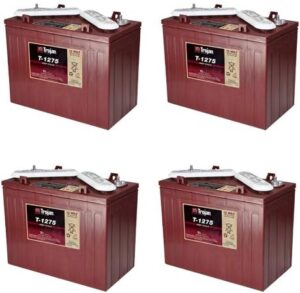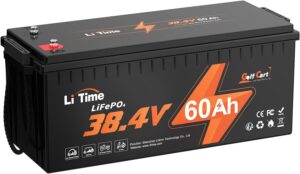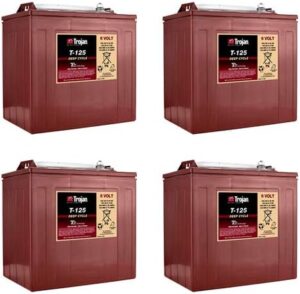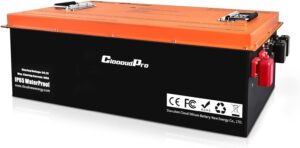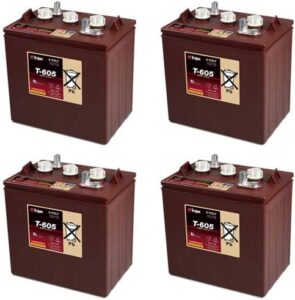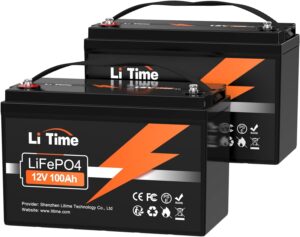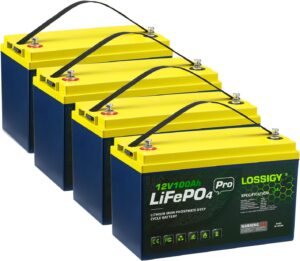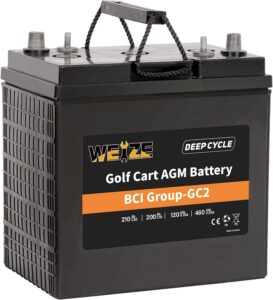Golf carts provide a convenient way to zip around the course, but only if the batteries are up to the task. Choosing the right batteries is crucial for optimal performance and longevity of your golf cart. In this buyers’ guide, we’ll discuss the key factors to consider when selecting new batteries for your golf cart, and provide recommendations for the best golf cart batteries currently available. Whether you need robust deep-cycle batteries or affordable replacements, we’ve got you covered.
List of the Best Golf Cart Batteries:
1. VATRER POWER 72V 105Ah Lithium Golf Cart Battery
With top-tier lithium iron phosphate cells, the Vatrer Power 72V 105Ah LiFePO4 golf cart battery delivers exceptional power. This battery is ideal for dominating the greens. With a mighty 14.08kW max output and 70.4V voltage, this battery packs a punch for blazing acceleration and conquering rugged terrain with ease. Besides, the built-in 200A BMS safeguards your investment through comprehensive protection features. Streamlined installation is easy with the compact, lightweight design that’s 50% lighter than lead-acid equivalents.
Furthermore, runtime reaches an impressive 70 miles per charge, eliminating range anxiety so you can golf for hours without interruption. Integrated app and LCD touchscreen monitoring allows real-time insight into battery performance. Moreover, with a stellar 4,000+ cycle lifespan, this lithium battery provides lasting value while minimizing replacement costs compared to lead-acid that last only 300-500 cycles.
Pros And Cons
2. US Battery 6V Golf Cart Battery
Providing robust power for golf carts, the US Battery GC2 6V 232Ah is a top-tier flooded lead-acid deep cycle battery. Boasting an ample 232 amp-hour capacity, this GC2 sized battery measures 10.25 x 7.125 x 11.25 inches and provides reliable cranking power and extended run times. The molded-in UTL terminals ensure secure cable connections to optimize conductivity. These batteries weigh 62 pounds each. Therefore, they are heavier than lithium options. However, they provide tried and true flooded lead-acid performance.
Moreover, US Battery is a trusted American battery brand, and their 2-year warranty gives peace of mind. While they require periodic maintenance like checking fluid levels, these batteries can handle repeated deep discharges day after day.
Pros And Cons
3. Mighty Max 12V 35Ah Golf Cart Battery
Boasting maintenance-free performance, the Mighty Max ML35-12GEL is an efficient gel battery option for golf carts needing reliable power. This 12V 35Ah sealed lead acid battery measures 7.68 x 5.16 x 7.13 inches, making it a compact yet mighty choice. The factory activated gel electrolyte resists leaks and spills. In addition, it eliminates the need to add acid. Designed for versatile mounting, this spill-proof battery can handle vibrations and high temperatures with ease. While the 35Ah capacity is lower than some choices, this light 23 pound battery is ideal for smaller golf carts or those needing an affordable gel battery solution. With proper charging and care, you can expect 2+ years of service life per battery.
Pros And Cons
4. OCELL 48V 40Ah Lithium Golf Cart Battery
Purpose-built for golf cart power, the OCELL 48V 40Ah LiFePO4 battery delivers robust lithium-ion performance to dominate the course. In addition, utilizing high-grade 3C cylindrical cells, this 40Ah battery produces a hefty 4096W max power output ideal for conquering slopes with ease. The integrated BMS safeguards your investment, providing comprehensive protection against abuse and extremes. What’s more, at just 44 pounds, it’s dramatically lighter than lead-acid alternatives for easy handling and installation in tight golf cart compartments.
Pros And Cons
5. Trojan T1275 12V 150AH Deep Cycle Golf Cart Battery
The Trojan T1275 is a robust, deep cycle battery. This heavy-duty battery is ideal for golf carts and renewable energy systems. With its large 150Ah capacity and Flooded Lead-Acid design, the T1275 provides reliable, long-lasting power. Furthermore, weighing in at 85 pounds each, these hardy batteries aren’t lightweight. However, they can handle repeated discharges for constant, powerful performance. The T1275 measures 12.96” x 7.13” x 11.13” making it a standard GC12 size that fits most golf cart battery compartments.
Not to mention, Trojan is known industry-wide for superior quality and expertise in deep cycle batteries spanning over 90 years. Their T1275 model delivers tremendous value, longevity, and trusted reliability. With proper maintenance like regular water refills and recharges, you can expect up to 5 years of service life from these top-tier batteries.
Pros And Cons
6. VATRER POWER 36V 105Ah LiFePO4 Golf Cart Battery
Packing seriously robust lithium power, the Vatrer Power 36V 105Ah LiFePO4 golf cart battery delivers up to a mighty 7.68kW of max output for dominating the greens. With integrated 200A BMS protection and a versatile 36V design, this 105Ah lithium iron phosphate battery brings advanced performance in a safe, golf cart-ready package. Besides, the handy LCD touchscreen allows real-time monitoring right from your cart. And at just 55 pounds, it shaves significant weight off lead-acid alternatives for easy handling and installation. Furthermore, you can expect 30-50 miles of runtime per charge—plenty for many rounds without downtime. Plus, this battery provides an exceptional 4,000+ lifespan, far outperforming lead-acid.
Pros And Cons
7. LiTime 36V 60Ah LiFePO4 Lithium GC2 Golf Cart Battery
Purpose-built for dominating the greens, the LiTime 36V 60Ah LiFePO4 golf cart battery delivers robust lithium-ion power in a compact GC2 size. In addition, utilizing high-grade cylindrical cells, it provides a continuous 120A discharge rate and max 4.6kW output for impressive acceleration. The integrated BMS safeguards your investment through comprehensive protection features. At just 44 lbs, it shaves significant weight off lead-acid alternatives for easy handling. Runtime reaches an estimated 30+ miles per charge—ample for many rounds. Moreover, with 4,000-15,000 cycles, this lithium battery far outlasts lead-acid while saving on replacements.
Pros And Cons
8. Trojan T-125 6V 240Ah Deep Cycle Golf Cart Batter
Known for deep cycle power, the Trojan T-125 6V GC2 battery delivers robust 240Ah capacity in a classic flooded lead-acid design perfect for golf cart demands. At 10.3 x 7.13 x 11.15 inches, these batteries fit most golf cart battery compartments. Moreover, the low profile embedded terminals ensure reliable conductivity and corrosion resistance. While heavy at 66 pounds each, the rugged build quality handles bumpy rides across 18 holes.
Pros And Cons
9. CloooudPro 48V 150Ah LiFePO4 Lithium Golf Cart Battery
Delivering robust lithium power to dominate the greens, the CloooudPro 48V 150Ah LiFePO4 golf cart battery packs a punch thanks to high-density A-grade cells. With integrated 300A BMS protection and a hefty 150Ah capacity, this lithium iron phosphate battery brings advanced performance and safety. The included 58.4V 20A rapid charger revives the battery quickly between rounds. Additionally, weighing just 79 pounds, this lithium battery is dramatically lighter than lead-acid for easy handling and installation. You can expect up to 70 miles of range per charge. And with a remarkable 6,000+ cycle lifespan that outclasses lead-acid, this battery delivers lasting value.
Pros And Cons
10. Trojan T-605 6V 210Ah Deep Cycle Golf Cart Battery
Offering robust flooded lead-acid power, the Trojan T-605 6V GC2 battery provides a hefty 210Ah capacity perfect for golf cart demands. At 10.30 x 7.11 x 11.07 inches, these batteries fit most standard golf cart battery compartments. Moreover, the embedded low profile terminals ensure reliable connections and corrosion resistance. While heavier than lithium at 58 pounds per battery, the rugged build quality handles bumpy rides across 18 holes.
Pros And Cons
11. LiTime 12V 100Ah LiFePO4 Lithium Golf Cart Battery
The LiTime 12V 100Ah LiFePO4 battery provides robust lithium-ion power. This battery delivers ample capacity in a safe, durable package. Rated at 100Ah with pure lithium iron phosphate cells, this lightweight 24 lb battery manages 1,280Wh for ample deep cycle runtimes. Besides, the integrated 100A BMS protects against abuse while allowing flexible series/parallel connections up to 51.2V 400Ah. Compared to lead-acid, these batteries provide 4,000 to 15,000 cycles for 10+ years of service life—far outlasting lead-acid. While costing more upfront, the long lifespan saves money over time.
Pros And Cons
12. LOSSIGY 12V 100Ah Lifepo4 Lithium Golf Cart Battery
Delivering robust lithium-ion performance, the LOSSIGY 12V 100Ah LiFePO4 battery packs a punch thanks to high-grade battery cells. Rated at a hefty 100Ah with pure lithium iron phosphate chemistry, this lightweight 24 lb battery manages 1,280Wh for ample deep cycling capacity. And, the built-in 100A BMS safeguards your investment through comprehensive protection features. In addition, flexible connectivity allows linking up to 4 batteries in series for 48V systems. Compared to lead-acid, these batteries provide 4,000+ cycles and 10+ years of service life—far outlasting lead-acid.
Pros And Cons
13. Weize 6V Golf Cart Battery
Designed for dominating the greens, the Weize 6V 210Ah AGM golf cart battery provides robust power thanks to true deep cycle AGM-GEL technology. In addition, with a hefty 210Ah rating, this Group GC2 battery measures 10.24 x 7.09 x 9.92 inches to fit most golf cart battery compartments. Moreover, the heavy-duty grid and paste design handles repeated discharges, while the double separator configuration ensures excellent cycling capacity and energy density. Even with rugged vibrations, the super anti-vibration build maintains stability for smooth operation. Furthermore, low self-discharge allows extended storage life. And at 67 pounds, it has the durability to withstand bumpy rides across 18 holes.
Pros And Cons
What Makes a Good Golf Cart Battery?
When it comes to golf cart batteries, there are several key factors that determine a good, high-quality battery. First and foremost is amp-hour capacity. Amp hours measure the amount of discharge a battery can provide over a 20-hour period. The higher the amp hours, the longer runtime and range you’ll get between charges. For most golf carts, you’ll want a battery with at least 175-230 amp hours.
Another crucial factor is reserve capacity. This measures how long the battery can continue operating your golf cart’s accessories like lights after being fully discharged. A higher reserve capacity is better for preventing getting stranded on the course. Most golf cart batteries have 60-90 minutes of reserve.
Battery construction and materials also differentiate good golf cart batteries. Higher-end batteries use thicker, heavier plates and a sturdier polypropylene exterior case to improve durability and vibration resistance over the long lifespan of a golf cart.
Deep cycle capability is another must. Golf cart batteries need to be deep cycle, meaning they can discharge most of their capacity before recharging, unlike batteries for starting engines. True deep cycle batteries can discharge down to 20% capacity.
Finally, quality golf cart batteries have higher electrolyte suspension characteristics to reduce water loss over time, maintaining consistent performance. Reputable brands also guarantee their batteries for at least 2-4 years when properly maintained.
Why is Battery Choice Important for Golf Carts?
The battery is quite literally the heart of any electric golf cart. Choosing the right battery is crucial because it directly impacts the cart’s performance, range, and longevity.
Range and Runtime
Golf cart batteries provide the power to run the electric motor that propels the cart. Higher quality batteries with higher amp-hour ratings can power a cart for longer distances on a single charge. Picking an underpowered battery will severely limit your maximum range before needing a recharge.
Performance and Acceleration
Golf carts rely on bursts of power from the batteries for acceleration and hill-climbing ability. Batteries with higher cold cranking amps and reserve capacity provide more available power for better acceleration performance.
Lifespan and Maintenance Costs
Higher quality deep-cycle batteries built specifically for golf cart use have much longer lifespans compared to cheaper automotive batteries. Premium batteries can last 4-6 years with proper care, while bargain batteries may only last 1-2 years. This impacts long-term maintenance costs.
Safety and Reliability
Cheap, low-quality batteries run a higher risk of failure, which at best leaves you stranded, and at worst can lead to fires or explosions. Name-brand golf cart batteries from reputable manufacturers prioritize safety.
Resale Value
If you ever go to sell or trade-in your golf cart, having older or sub-par batteries installed reduces the resale value substantially compared to a well-maintained cart with quality batteries.
How to Choose the Best Golf Cart Batteries?
Buying new batteries for your golf cart is an important investment. You want batteries that will provide strong, reliable power to keep you cruising across the greens all day long. However, with so many battery options on the market, it can be tricky to choose the right ones for your specific needs. This guide will walk you through the key factors to consider when selecting new golf cart batteries. Follow these tips to find the perfect power source for your vehicle.
1. Consider Your Usage
First, think about how often you use your golf cart and for what purposes. Do you just cruise around the golf course a few times per week? Or do you rely on your cart for heavy day-to-day use around your property? High-capacity deep cycle batteries are best for frequent, heavy usage. While less expensive starter batteries can work for lighter duty cycles. First, consider how many miles you travel in your golf cart each week. Next, choose batteries suited for that level of wear and tear.
2. Pay Attention to Battery Specs
Once you’ve determined your usage, look at battery specs to find options that fit your needs in terms of capacity, lifespan, and maintenance. Higher amp-hour (Ah) ratings indicate greater capacity and range. Opt for the highest Ah rating you can afford. Look for batteries advertised as “maintenance-free” if you want to avoid frequent fluid checks and refills. Absorbed glass mat (AGM) batteries are spill-proof and ideal for golf carts.
3. Consider Your Climate
Climate impacts battery performance. For instance, in hot regions, choose batteries designed to withstand high temperatures. Look for cold cranking amps (CCA) ratings over 500 for cold weather operation. Getting batteries meant for your climate will ensure optimum power regardless of the weather.
4. Choose Reputable Brands
When shopping for new golf cart batteries, stick with well-known, reliable brands. Specifically, Trojan, U.S. Battery, and VATRER are top manufacturers of high-quality batteries. The big players manufacture high-quality batteries that live up to their performance claims. Pay a little more for batteries from reputable manufacturers that back their products with solid warranties.
5. Check Battery Dimensions
Make sure any new batteries you buy are the same dimensions as your existing ones to ensure proper fit. It’s annoying to get new batteries home only to find they don’t slide all the way into your battery compartments. Measure your current batteries and get the height, width, and depth dimensions so you can match them up.
Choosing new batteries for your golf cart requires some careful consideration. Keep these tips in mind as you shop to find the right power solution. Look for deep cycle batteries with ample Ah ratings and power specs suited for how you use your vehicle. And don’t forget to check battery dimensions for a quick and easy replacement! Investing in the best quality batteries from top brands will keep your golf cart cruising for years to come.
What are the Different Types of Golf Cart Batteries?
While golf carts use several different battery types, they generally fall into two main categories – lead-acid and lithium-ion.
Lead-Acid Batteries
These are the most commonly used batteries for golf carts. There are three primary lead-acid battery types:
Flooded Lead-Acid
The original and most affordable option. These wet cell batteries have a liquid electrolyte solution that needs periodic refilling with distilled water. They require venting and more maintenance but can last 4-5 years.
Gel Cell Lead-Acid
Gel batteries use a semi-solid electrolyte suspended in a silica gel, making them sealed and maintenance-free. They are more resistant to heat, vibration, and charging issues but cost more upfront.
Absorbed Glass Mat (AGM) Lead-Acid
AGM batteries have the electrolyte absorbed into a glass mat between the plates. This design is also sealed and maintenance-free with improved charging performance and efficiency over flooded models.
Lithium-Ion Batteries
The newest and most advanced golf cart battery type uses lithium-ion technology similar to batteries for electric vehicles and portable electronics. The main advantages are:
Lighter Weight: Lithium batteries weigh 1/3 as much as lead-acid for increased range/efficiency.
Higher Energy Density: They can store more power in the same space for longer runtimes.
Faster Charging: Most can recharge to 100% in just 2-4 hours.
Longer Lifespan: When properly maintained, lithium batteries can last 5-10 years.
The main downsides are lithium batteries have higher upfront costs and require specialized battery management systems.
While lead-acid remains most common currently, lithium-ion is rapidly gaining popularity for premium golf carts due to the performance benefits. Choosing between these main types depends on your budget and prioritization of range, weight, charging, and longevity.
Lead-Acid vs Lithium-Ion: Which is Better for Golf Carts?
The debate between lead-acid and lithium-ion batteries has been ongoing for golf carts. Both have their pros and cons, so let’s weigh the key factors:
Weight and Size
One of the biggest advantages of lithium-ion batteries is their lighter, more compact size and weight. A lithium pack can weigh 1/3 as much as an equivalent lead-acid pack. This reduces weight on the cart for better range and efficiency.
Runtime and Range
Lithium-ion batteries have a higher energy density, allowing them to store more power in the same physical space. This translates to 20-40% more runtime and range compared to lead-acid packs.
Charging Time
Lead-acid batteries take 8-10 hours for a full charge. Lithium-ion batteries can fully recharge in just 2-4 hours, which is a major convenience.
Lifespan and Maintenance
This is where lithium-ion pulls ahead. A well-maintained lithium battery can last 5-10 years, 2-3 times longer than lead-acid. Lithium is also maintenance-free with no watering required.
Cold Weather Performance
Lead-acid batteries can struggle in cold conditions. Lithium-ion batteries maintain more consistent power delivery in freezing temperatures.
Initial Cost
Lithium-ion batteries have higher upfront costs, often 2-3 times more expensive than premium lead-acid batteries for the same performance.
Overall, lithium-ion batteries provide significant advantages in weight, runtime, charging, lifespan, and cold performance. However, the higher initial investment cost is the main barrier.
How Long Do Golf Cart Batteries Typically Last?
The lifespan of golf cart batteries can vary considerably depending on the battery type, usage patterns, and maintenance. However, there are some general guidelines on what to expect:
Lead-Acid Batteries
The most common lead-acid batteries for golf carts include flooded, gel, and AGM types. With proper care and maintenance, these can typically last:
Flooded Lead-Acid: 4-5 years Gel Cell Lead-Acid: 3-5 years
AGM Lead-Acid: 3-6 years
Several factors influence lead-acid battery life including:
- Depth of discharge per cycle
- Ambient temperatures
- Frequency of charging
- Quality of charging system
Consistently deep discharging, extreme heat/cold, infrequent charging, and improper charging voltages can significantly shorten battery life.
Lithium-Ion Batteries
The advanced lithium-ion batteries used in premium golf carts have a much longer expected lifespan when maintained correctly:
Lithium-Ion: 5-10 years
Lithium batteries last 2-3 times longer because they can withstand partial state of charge without damage, have less electrolyte saturation, and are less prone to sulfation buildup over time.
However, lithium batteries are not completely maintenance-free. Factors like preventing over-charging, extreme temperatures, and impact loads are still important for maximizing their lifespan.
No matter the battery type, proper maintenance like charger settings, water refilling, cleaning terminals, and storage procedures can help ensure you get the full rated lifespan. But eventually all batteries will need replacement as they inevitably degrade cycle after cycle.
How Can You Extend the Life of Your Golf Cart Battery?
Proper care and maintenance are key to maximizing the lifespan of your golf cart’s battery pack. Here are some top tips to help extend battery life:
Avoid Deep Discharging
For lead-acid batteries, try to avoid depleting the charge below 50%. For lithium-ion, don’t go below 20% state of charge. Deep discharging puts more strain on the batteries.
Charge Regularly and Fully
Don’t let batteries sit discharged for long periods. Make sure to fully recharge after each use, which allows the batteries to cool down and re-balance cells.
Use Approved Battery
Chargers Only use the battery charger type recommended by the manufacturer set to the proper voltage settings. Incorrect chargers can overcharge or undercharge batteries.
Check Water Levels
For flooded lead-acid batteries, regularly check and refill water levels up to the fill line with distilled water to replenish electrolyte levels.
Keep Terminals Clean
Frequently clean battery terminals to prevent corrosion buildup, which can drain batteries faster. Use a baking soda/water solution and battery terminal protectors.
Proper Battery Storage
For seasonal storage, fully charge the batteries, disconnect cables, and keep them charged at least every 6-8 weeks to avoid sulfation buildup.
Rotate Battery Use
For carts with multiple battery packs, rotate which ones you use to encourage even discharge cycles across all batteries.
Reduce Electrical Accessory
Use Accessories like fans, coolers and stereos create more electrical load and drain batteries faster. Use sparingly when not needed.
Consider a Battery Maintenance System
These smart chargers/desulfators can use pulses to reduce sulfation and equalizers to balance cells, extending battery life further.
Replace When Needed
When batteries no longer hold a sufficient charge, don’t try to limp along – replace them to avoid damaging the cart’s electrical system.
Following these tips can help you get the maximum lifecycle and best performance out of your golf cart battery investment.
When is it Time to Replace Your Golf Cart Battery?
Even with proper care and maintenance, all golf cart batteries will eventually reach the end of their usable lifespan and need to be replaced. But how can you tell when it’s time? Here are some key signs to watch for:
Loss of Runtime/Range
One of the first indicators is if you notice a significant reduction in how far you can travel on a full charge compared to when the batteries were new. A 20-25% drop-off is typically considered the threshold for replacement.
Longer Charging Times
As batteries age and lose capacity, it will take longer than usual to fully charge them from a depleted state. Charging times increasing by several hours is a red flag.
Heavy Sulfation Buildup
For lead-acid batteries, you may see excessive white or blue crystals forming on the battery case near the terminals – a sign of sulfation from acid deterioration.
Physical Damage or Swelling
Any physical casing damage from drops/impacts, or batteries appearing to swell or become misshapen means unsafe internal issues.
High Maintenance Requirements
If you’re having to top off water levels, clean terminals, or equalize frequently to keep batteries operational, the batteries are on their last legs.
Old Age
Even if batteries still appear functional, it’s wise to replace lead-acid packs every 5 years and lithium-ion around 8-10 years as they become less reliable over time.
Battery Testing
You can also have batteries load tested to check their actual amp-hour capacity and voltage levels to determine if they meet minimum specifications.
When in doubt, it’s better to replace batteries as a set rather than mixing in new with old, which can lead to further imbalances. Pushing heavily degraded batteries increases risks like getting stranded, overheated batteries, or even fires. Listen to the warning signs and prioritize safe, reliable battery replacements.
Frequently Asked Questions When Picking the Best Golf Cart Batteries
1. What type of batteries work best in golf carts?
Deep cycle batteries are best for golf carts because they are designed to provide steady power over long durations rather than short bursts. Popular deep cycle battery types for golf carts include flooded lead-acid, absorbed glass mat (AGM), and gel cell batteries.
2. How long do golf cart batteries last?
With proper care and maintenance, quality deep cycle batteries can last 3-5 years in a golf cart. Usage impacts lifespan. If used daily, they may only last 2-3 years. Light use could extend life to 4-6 years. Signs it’s time for replacement include needing frequent recharges and decreased range.
3. How much do new golf cart batteries cost?
Expect to pay $100-$300 per battery. Sets of 4-8 batteries for 48V and 72V carts can range from $500-$2,000 or more. Higher Ah ratings, premium brands, and AGM/gel cell types cost more than basic flooded batteries. But they can be worth it for longer lifespan and reduced maintenance.
4. What Ah rating is best for golf cart batteries?
Go with the highest Ah rating you can afford. For heavy, daily use aim for 225Ah batteries. Moderate usage golf carts can get by on 200Ah batteries. And 150Ah may suffice for light duty cycles. Higher Ah means extended run times between charges.
5. How to choose the right size golf cart batteries?
Check your existing batteries for dimensions and match to replacements. Common sizes are GC2, GC8, and GC12. Make sure new batteries have terminals in the same positions to properly fit your cart’s battery compartments and connections.
6. What are the best golf cart battery brands?
Top brands for quality and reliability include Trojan, U.S. Battery, VATRER, LiTime and Mighty Max. Compare warranties when choosing brands. Many come with 1-year warranties, but some Trojan AGM batteries have up to a 7-year warranty.
7. How can I get the maximum life from my golf cart batteries?
Fully charge after each use, don’t let them sit in low state of charge, clean terminals regularly, check water levels monthly (flooded type), avoid excessive loads/over-draining, and don’t expose to extreme temperatures. Also consider battery tenders/de-sulfators.
8. When is it time to replace my golf cart batteries?
Signs for replacement include needing to recharge more often, decreased range per charge, corrosion on terminals, no improvement after proper charging, and inability to hold a charge. Most flooded batteries need replacement once hydrometer readings drop below 1.220.
Final Thoughts
Finding the right batteries is one of the most important decisions you’ll make to keep your golf cart running strong. Now that you know how to evaluate your usage needs, compare technical specs, choose trusted brands, and watch for replacement signs, you’re ready to select the ideal batteries for your cart and budget. Investing in a robust set of deep cycle batteries from a leading manufacturer will provide you with reliable power and optimal longevity. With your new batteries in place, you can hit the greens worry-free, knowing your golf cart has the power supply it needs to transport you around all 18 holes in style.
Enjoyed this guide of the best golf cart batteries? Then be sure to check out our other golf guides.

